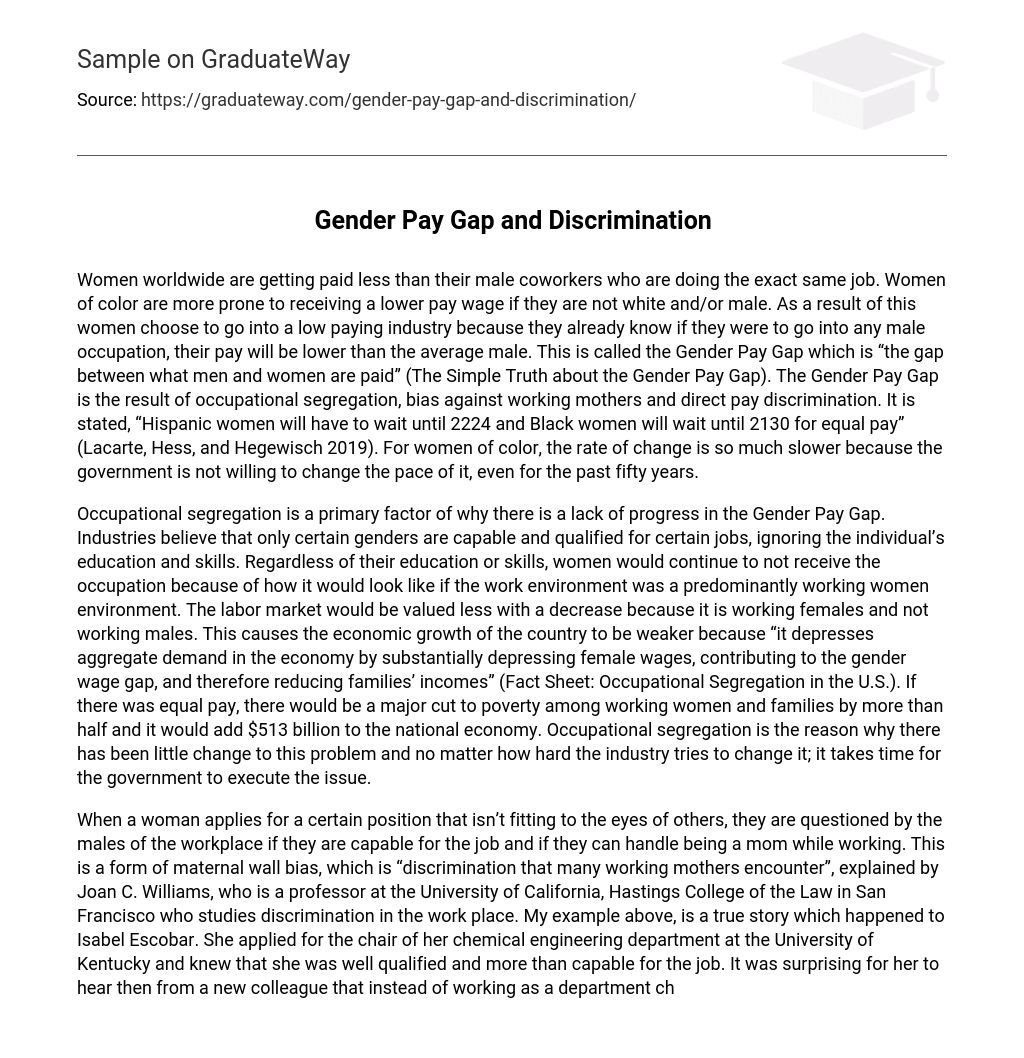Women worldwide are getting paid less than their male coworkers who are doing the exact same job. Women of color are more prone to receiving a lower pay wage if they are not white and/or male. As a result of this women choose to go into a low paying industry because they already know if they were to go into any male occupation, their pay will be lower than the average male. This is called the Gender Pay Gap which is “the gap between what men and women are paid” (The Simple Truth about the Gender Pay Gap). The Gender Pay Gap is the result of occupational segregation, bias against working mothers and direct pay discrimination. It is stated, “Hispanic women will have to wait until 2224 and Black women will wait until 2130 for equal pay” (Lacarte, Hess, and Hegewisch 2019). For women of color, the rate of change is so much slower because the government is not willing to change the pace of it, even for the past fifty years.
Occupational segregation is a primary factor of why there is a lack of progress in the Gender Pay Gap. Industries believe that only certain genders are capable and qualified for certain jobs, ignoring the individual’s education and skills. Regardless of their education or skills, women would continue to not receive the occupation because of how it would look like if the work environment was a predominantly working women environment. The labor market would be valued less with a decrease because it is working females and not working males. This causes the economic growth of the country to be weaker because “it depresses aggregate demand in the economy by substantially depressing female wages, contributing to the gender wage gap, and therefore reducing families’ incomes” (Fact Sheet: Occupational Segregation in the U.S.). If there was equal pay, there would be a major cut to poverty among working women and families by more than half and it would add $513 billion to the national economy. Occupational segregation is the reason why there has been little change to this problem and no matter how hard the industry tries to change it; it takes time for the government to execute the issue.
When a woman applies for a certain position that isn’t fitting to the eyes of others, they are questioned by the males of the workplace if they are capable for the job and if they can handle being a mom while working. This is a form of maternal wall bias, which is “discrimination that many working mothers encounter”, explained by Joan C. Williams, who is a professor at the University of California, Hastings College of the Law in San Francisco who studies discrimination in the work place. My example above, is a true story which happened to Isabel Escobar. She applied for the chair of her chemical engineering department at the University of Kentucky and knew that she was well qualified and more than capable for the job. It was surprising for her to hear then from a new colleague that instead of working as a department chair, she should be home with her small child. The colleague viewed her as a less competent person because she was a mother and the colleague would probably view a pregnant woman the exact same way. Maternal wall bias is manifested in many ways, coming from hiring committees, colleagues, and individuals conducting performance evaluations.
Due to these manifested ideas of women, mothers specifically are overlooked for challenging assignments, promotions because of their lack of time or desire, and sometimes because they are told that they should be home with their children instead of working. Men are then given the assignments and promotions because they are not told to stay home and to be with their children. This view that women cannot be good workers and good parents at the same time is spreading everywhere. A study was done in 18 countries over 50,000 individuals. The researchers found a so called “motherhood myth”, that if women work and is a mother, the children and families will suffer. It is believed that a women’s job is to stay home and take care of the home and family; a man’s job is to go to work and earn money for the household. This belief was found all over in the 18 countries that was a part of the research. Women have been shunned for many years if they decide to work and take care of their family. Instead we should be accepting and advocating for the mother who is doing jobs.





